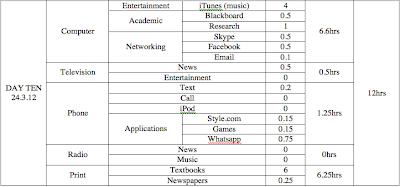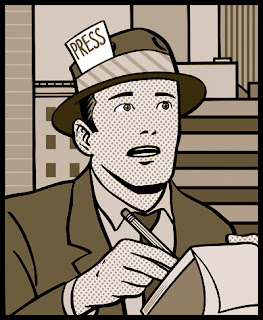10 DAY MEDIA DIARY TABLE/S
Note: 1 Text Message = 1 Minute
10-DAY MEDIA DIARY GRAPH - All Mediums
Data broken down...
Computer
Television
Phone
Print
Radio
SUMMARY
It is safe to say that, in
a lot of cardinal ways, media defines our 21st Century existence. It is indeed
the language of globalisation, providing us with an extraordinary capacity to
truly be an international citizen. Media offers an interactive platform for almost
anything - whether it be to communicate, to teach, to learn, to entertain, to
share, to produce, to consume, to publish, to test, or to simply enjoy. It is
boundless, transformative, accessible and seemingly integral to common daily life - the extent of its essentiality, only growing. Thus, I, as a fully-fledged media
buff and 21st Century journalism student, will attempt to understand media's
impact on me personally through a detailed analysis of its usage and
production. Rising to the challenge, I have recorded, comprehensively, my media
usage over a 10-day period and will summarise and analyse the results, paying
specific attention to my journalistic media intake.
*
The largest medium that I
found myself employing in the 10-day period was the computer, specifically its
Internet capability. I was not at all surprised that the Internet skyrocketed
to the top of my overall media usage, encompassing social networking,
entertainment and academic consumption. It also proved itself to be my go-to medium for
news intake. The prevalence of journalistic articles on sites such as Facebook
and Twitter, and references to stories in blogs, made it easy for me to get a quick fix.
Twitter, more so than Facebook, was quite heavily news-orientated. Having never
been a "tweeter" prior to this course, like 70.8% of my peers as
discovered in the peer survey (shown in Figure 1 below), I was initially a
little unsure as to what it entailed, and looked at it in quite a
perfunctory manner. However, attempting to overcome my anti-Twitter mindset in the seventh day
of my media recording, I embraced the networking site, which has now become one
of my main news outlets. I have found myself able to easily read the latest
stories through 'following' Twitter pages for newspapers and
magazines. Facebook, blogs and more recently Twitter comprise my online
newsfeed, supplying me with quick and simple summaries of the news more so than
hard-hitting, dense journalism.
Figure One: Number of Twitter accounts before JOUR1111 (Peer Survey)
The Internet was also the
sole enabler of my personal media production. This production evidenced itself
in the form of Facebook statuses, my sharing of links to YouTube videos and other
pages, and most obviously, this blog. I had never considered myself an active
‘producer’ of media, but it seems I am!
Another interesting realisation
was that I never have only one page open on the computer. My screen is forever filled
with multiple Internet tabs, word documents, powerpoints, videos, and
applications - my well-versed fingers flicking between them with quicksilver certainty. I think that rather simply and effectively captures the ease at which my
generation handles media multi-tasking – our personal growth happening harmoniously
alongside media's rampant development.
*
My record of print, phone
and television usage proved to be quite similarly ranked below that of the
computer. This result unearths a slight inaccuracy in the test. In order to
equate a text message with all other figures of duration, I made 1 text message
equal 1 minute. This, however, is a generalisation, and I believe my phone
usage would have, scarily enough, been higher than this had I accurately
recorded the individual time spent sending and reading each text message.
As a true 21st Century
child, my iPhone is like my right arm. It is a lot like having a laptop in my
pocket, with the additional ability of call and text – constantly allowing me access to a variety of media sources. This is both an example of my continuous
exposure to media, and of just how heavy my reliance is. In the peer survey it
was shown that 77.3% of us have Internet enabled smartphones (as seen in Figure 2 below), hinting at the
fact that I am not alone. Applications are shown to be the most used element of
my phone. This is mostly because of one specific application called “whatsapp”
– a free instant messaging facility between all smartphones that is used in
conjunction with text and call as my main methods of communication.
Figure Two: 'Smartphone' possession (Peer Survey)
*
From a purely journalistic
perspective, I interact with ‘the news’ primarily through the Internet,
followed at a lesser degree by television news programs (which seemed to be the
favourite of my peers as shown in Figure 3 below) and the seemingly ancient
invention of the newspaper. Whichever source, my news exposure is categorically
interest-based. The ‘searchability’ of news on the Internet, coupled with the
emergence of Web 3.0, which employs the methods of hyperlocalisation and ‘news
my way’, makes reading the news a pleasurable and highly engaging experience –
my personal interests dictating the stories I am fed. Similarly, my watching of
the news on television and reading of the it in newspapers is shamefully
half-hearted, that is unless there’s a segment, a story or a photograph that
particularly captures my attention. I have therefore found that my exposure is almost completely to 'soft news', where human interest stories are privileged.
*
By recording my media use
and production over a period of 10 days I was made startlingly aware of my
absolute reliance on it in almost all facets of my daily life. This realisation,
however, has ceased to change my ways. As I write this, I have seven Internet
pages, two word documents, a PDF and iTunes open, textbooks and newspapers
sprawled across the table, the television’s reflection dancing in the window to
my left and my phone next to me buzzing melodiously.


































